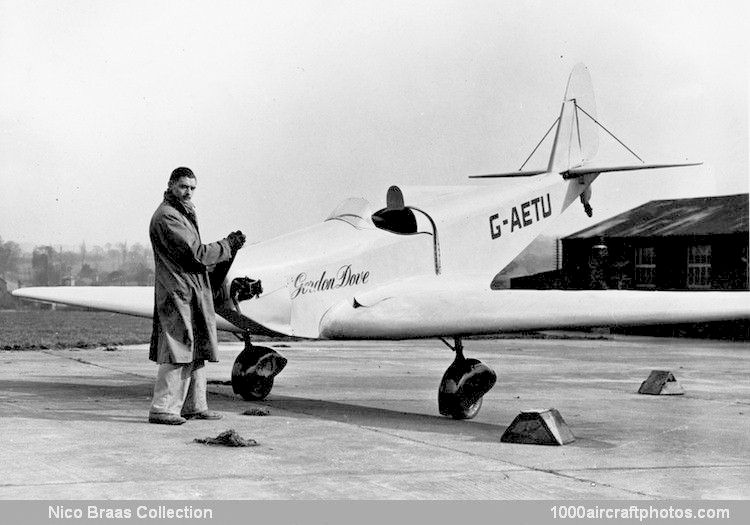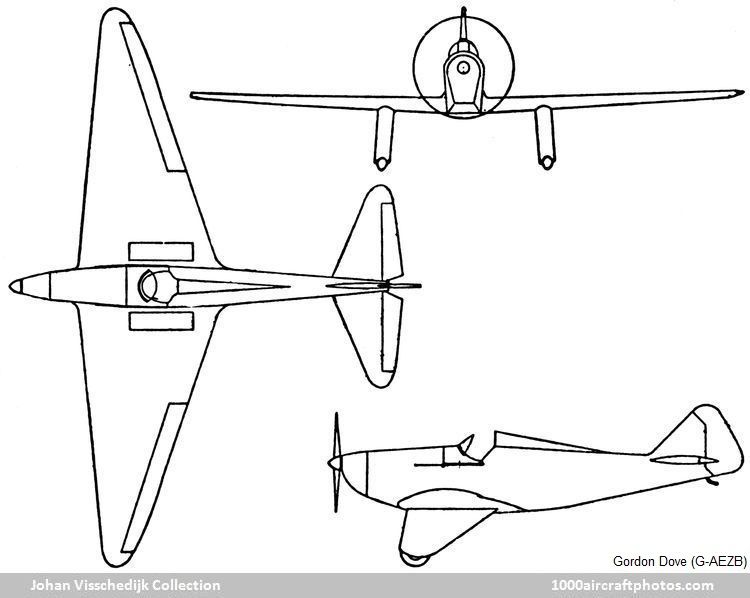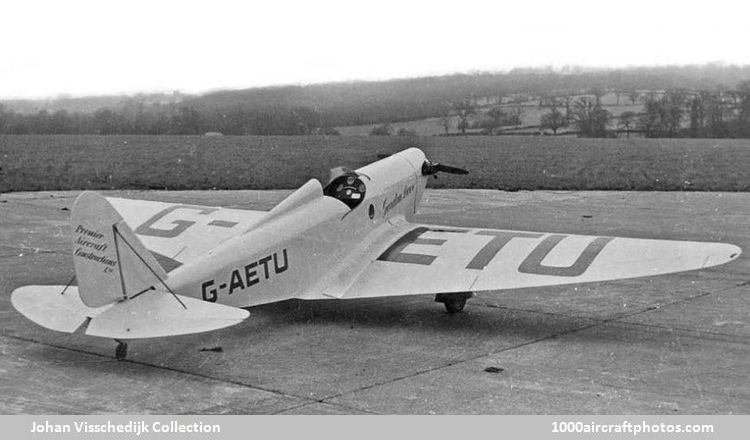12/15/2021. Remarks by
Johan Visschedijk: "In 1935, Raymond Gorden and Mervyn G. Chadwick initiated the development of an ultralight low-cost single-seat monoplane. In June 1935, the prototype of the Belgian
Tipsy S sport aircraft was demonstrated in England, inspiring Gordon and Chadwick to produce a similar aircraft.
Sydney C.G. Buszard was responsible for the design of the aircraft, by then designated Gordon Dove, and on November 2, 1936, Gorden and Chadwick formed Premier Aircraft Constructions Ltd. at Maylands Aerodrome, Harold Park, Essex, were the prototype was to be constructed. Hence the aircraft is also referred to as Premier Aircraft Dove and Premier Aircraft Gordon Dove. Registered G-AETU and with C. 'Ossie' Oscroft at the controls, the prototype first flew on March 3, 1937; its 'Authorization to Fly' was issued the following day. The aircraft was registered to the Romford Flying Club at Maylands Aerodrome on January 14, 1938. Two years later, February 6, 1940, it was damaged beyond repair in a hangar fire at Maylands Aerodrome.
Two more aircraft were built. The first was registered G-AEZA (c/n S.B. IV) on June 21, 1937, its 'Authorization to Fly' was issued the following month and the aircraft was delivered to the Earl of Cardigan, David Brudenell-Bruce of Marlborough, Wiltshire. The aircraft was withdrawn from use on May 2, 1939 and subsequently scrapped.
The second was registered G-AEZB (c/n S.B. III) to John Keane Flower of London on June 20, 1937.
This aircraft had a number of changes as visible in the 3-view. Instead of wheels with streamline fairings, it was fitted with a trousered landing gear, horizontal and vertical surfaces were revised and the strut bracing of the fin was abandoned. First flown in August 1937, it received its 'Authorization to Fly' on August 24, 1937, and the aircraft was based at Denham, Buckinghamshire. However, two weeks later, September 9, G-AEZB was damaged in a forced landing near Tilbury, Essex. It was returned to Denham and was repaired. It was offered for sale in 'Flight' on March 3, 1939, as "just thoroughly overhauled; 22 hours; perfect". Presumably not sold, the aircraft then went into store with Luton Aircraft at Barton-in-the-Clay, Bedfordshire, until September 1939, whereafter it disappeared. Retroactively it was deregistered by the CAA on December 1, 1946.
Another five registrations, G-AFAC to G-AFAG, were allotted, but these aircraft were not built. Premier Aircraft Constructions Ltd. went into Receivership in August 1938.
Type: Single-seat ultralight monoplane.
Wings: Low-wing cantilever monoplane. Outer sections of wing quickly detachable. Wing structure consisted of one main box-spar transversely braced to a subsidiary rear spar, former ribs and plywood covering over leading edge to rear spar, with fabric covering on trailing-edge.
Fuselage: Rectangular wooden framework with domed roof, the whole covered with plywood.
Tail unit: Braced monoplane type. Wooden framework, with fabric covering. All control surfaces horn balanced.
Landing gear: Divided type. Consisted of two cantilever long travel telescopic shock absorber legs with medium-pressure wheels carried in forks. Wheels enclosed in streamline fairings.
Power plant: A 28 hp Aero Engines Sprite opposed two-cylinder air-cooled engine mounted on rubber blocks on steel-tube bearers braced laterally. Any other engine of approximately 100 lb (45 kg) in weight and 30 hp could be fitted. Fuel tank in fuselage. Oil tank below engine, with surface cooling.
Accommodation: Open cockpit over wing. Coupé cockpit cover optional. Adjustable pilot's seat. Baggage locker behind cockpit.


